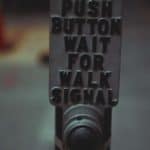HOW TO PRACTICE THE ART OF OF WAITING

 The art of waiting often depends on what we are waiting for. Wouldn’t it be nice if what we wait for were as simple as a walk light or a mouse? These things call for a bit of patience, mingled with anticipation or angst. But what about waiting for things that are not as tangible? A diagnosis, an answer to prayer, or maturity? (Photos by Eilis-Garvey and Marnhe-du-Plooy on Unsplash)
The art of waiting often depends on what we are waiting for. Wouldn’t it be nice if what we wait for were as simple as a walk light or a mouse? These things call for a bit of patience, mingled with anticipation or angst. But what about waiting for things that are not as tangible? A diagnosis, an answer to prayer, or maturity? (Photos by Eilis-Garvey and Marnhe-du-Plooy on Unsplash)
What is the hardest thing you ever waited for? When I was six years old, I could hardly wait for the first day of school. It was more exciting to me than Santa Claus, the Easter Bunny, and the Tooth Fairy all rolled together. I no longer believe in this holy trinity of childhood.
But some stars shine in the universe of being an adult that leave me holding my breath as I wait for what is to develop. The birth of a child or grandchild. News that moving day is getting close. Waiting for daffodils to bloom through the late spring snow.
And my favorite – waiting for the mail to come. I love getting surprises in a box! It doesn’t matter what the box holds – it could be a book, kibble for the dog, or a replacement cord for my iPhone. To me, if it is in a box, it’s a “toy,” and a day without toys is somehow longer.
IS THERE A BENEFIT TO WAITING?
Al l this waiting elicits a surge of hormones that come whenever we look forward to new things that will change our lives. The waiting gives our inner selves time and space to prepare for whatever, or whoever, is coming next.
l this waiting elicits a surge of hormones that come whenever we look forward to new things that will change our lives. The waiting gives our inner selves time and space to prepare for whatever, or whoever, is coming next.
I think the design of human pregnancy and childbirth teaches us profound truths about waiting. If babies popped out like mosquito bites, we would not have time to do anything except scratch them when they get irritating. Waiting for 9 months raises their inherent value as well as our longing for their arrival. We become more robust and wiser in the waiting. Photo by Devon-Divine on Unsplash)
WHAT MAKES IT DIFFICULT?
 If I were to choose one thing that creates the most stress in the waiting process, it would be attachment to the outcome. How tightly we hold to our desire for something to happen (or not) stimulates the magnitude of our experience of waiting.
If I were to choose one thing that creates the most stress in the waiting process, it would be attachment to the outcome. How tightly we hold to our desire for something to happen (or not) stimulates the magnitude of our experience of waiting.
For example, when I have no attachment to the rain, it doesn’t particularly bother me if or when clouds gather ominously overhead. However, if it hasn’t rained in weeks and the lawns and gardens are thirsty, the wait for showers is interminable.
On the other hand, if I had planned to take a hike in nature and those same clouds appeared, my reaction would be, “What, again?!” And I would then be waiting impatiently for the showers to pass. And if I am honest, I would feed my stress at not being able to hike with a fistful of Oreos. (Photo by Elizaveta-Korabelnikova on Unsplash)
WHAT MAKES WAITING EASY?
 Non-attachment. The more I let go of the desired outcome, the less anxiety changes my chemistry, and I feel more patient and able to wait. The name for this is homeostasis or balance. It signals the healthiest state possible for our bodies as well as our spirits. Balance in our spirit, called ‘equanimity,’ is a place of serenity and groundedness that is comfortable with waiting.
Non-attachment. The more I let go of the desired outcome, the less anxiety changes my chemistry, and I feel more patient and able to wait. The name for this is homeostasis or balance. It signals the healthiest state possible for our bodies as well as our spirits. Balance in our spirit, called ‘equanimity,’ is a place of serenity and groundedness that is comfortable with waiting.
But, you say, it isn’t easy to let go of looking for the birth of a healthy child, the results of a lab test, or even seeing a beautiful green lawn after a long dry spell. No, it isn’t. Sorry, I don’t have a simple answer to that. But I can share what helps me. (Photo by Jason-Lam on Unsplash)
ONE PRACTICE THAT HELPS
LOWER ANXIETY AS WE WAIT
 Consider a flying trapeze artist. He or she cannot hang on to two rings simultaneously without being torn in two if the goal is to fly from one side of the circus tent to the other. Neither can I hold on to my desires tightly and expect to ‘fly’ with freedom in the process of waiting.
Consider a flying trapeze artist. He or she cannot hang on to two rings simultaneously without being torn in two if the goal is to fly from one side of the circus tent to the other. Neither can I hold on to my desires tightly and expect to ‘fly’ with freedom in the process of waiting.
I am a ‘ring-grabber’ in life, never content to passively sit and watch life swing overhead. When I reach for the rings in life, it is with the knowledge that I will have to let go of one to grab the other. (Photo by Victor-Freitas on Unsplash)
I get a lot of practice in letting go. This practice has taught me that letting go only looks scary. Keeping my eye on the next thing – baking bread, going for a walk, or even vacuuming the floor, keeps me from waiting anxiously. The length of the wait doesn’t change. My anxiety and impatience do. Click here to read more about The Art of Letting Go
WAITING FOR AN ANSWER TO PRAYER
Waiting for an answer to prayer tests our faith, regardless of our theology about “who” does the answering. Our hearts release their deepest needs into the universe – perhaps formal prayer in community with others, or silent contemplation on a cushion, or in a notebook as a letter addressed “Dear Journal.”
 I confess I am often like an indulged toddler or hungry kitten when it comes to prayer. I know what I want, and it must be precisely right and good for me, or else I wouldn’t want it. And I want it now!
I confess I am often like an indulged toddler or hungry kitten when it comes to prayer. I know what I want, and it must be precisely right and good for me, or else I wouldn’t want it. And I want it now!
As a toddler, my vision is quite narrow, and my understanding is limited. Sometimes I can get my wants by throwing a tantrum or conversely by being very charming. In any event, I am not good at waiting.
It takes practice. A lot of it. I am still practicing. (Photo by Hulki-Okan-Tabak on Unsplash)
WAITING AS SPIRITUAL PRACTICE
 Where do you file ‘waiting’ in your life? Is it on the bookshelf and something you have never looked at? Perhaps the practice of waiting is framed on the wall, overseeing everything you do. Or would you look for it in the freezer with a bunch of other leftovers from a spiritual life no longer practiced?
Where do you file ‘waiting’ in your life? Is it on the bookshelf and something you have never looked at? Perhaps the practice of waiting is framed on the wall, overseeing everything you do. Or would you look for it in the freezer with a bunch of other leftovers from a spiritual life no longer practiced?
Like any practice, the best way to begin (again) is with very tiny steps. Before I ever played a song on a musical instrument, I had to practice how to hold it. After I had left playing for a few years, I had to start all over again, learning simple scales. (Photo by Ethan-Kent on Unsplash)
As you think about other ‘practices’ you have in your life (brushing your teeth, watering the plants), you will remember that they began with desire, followed by repetition. So too, with any spiritual practice, including waiting. Repetition never ends. That may be why the universe gives us opportunities to ‘let go’ again and again, as we grow in patience.


Crystal Gwinn
How much of our lives are we waiting for either good (things to occur) or bad (things to end), and so doing miss out on the present moment. Powerful last sentence in this reflection.
Ardis Mayo
Yes, coming and going. Seldom ‘being’.
Terrie Mourningdove
Waiting patiently has always felt like a negative to me, but you have changed my mind about that. It IS important and so useful. Thank you Ardis.
Ardis Mayo
You are welcome, Terrie.
Judith Scarborough
This reflection is just what I needed today, as I grow weary of the quarantine. I am looking for strategies to find gratitude for the blessings in my current life that will allow me to move gracefully in this newly defined world order. Being still and learning to wait will surely help. Thank you, Ardis!
Ardis Mayo
You are welcome, Judith. When I get feedback from people like yourself, I am encouraged in what to write about. It definitely feels like anything having to do with our struggles right now is game for topics. Thank you.
Brian Wild
Lovely essay Ardis! Currently involved in a waiting game out of my control, this was an inspirational read that put me in better spirits.
Sometimes when you are truly helpless to a situation, and are asking why, you loose sight of the fact that things are out of your hands.
Sometimes you need to be reminded that you can cut the cord that binds you to a situation that is above your earthly human capabilities and give yourself some much needed slack.
This read helped me remind myself, and provided some calm and ease, and a bit of relief! Thank you 🙂
Ardis Mayo
I am so glad you found this helpful, Brian. We all grow up learning to control everything from our bowels to our appetites. Learning to let go and wait is counter to a lot of that training. One thing that is important to remember is we are all in this together!